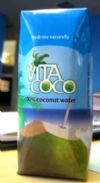|
Mother knows best. Back in 2005, my mom starting telling me about this "amazing" seed that was great for health. She added it to smoothies, granola, breads, and just about everything else. Flax, I quickly learned, was versatile and an easy way to integrate those heart-healthy Omega-3 fatty acids into my diet. But as much as I love flax for its nutritional benefits (fiber, lignans, the aforementioned Omega3s and protein), there are a couple of caveats when using it in recipes: Flax must be ground for our bodies to process it. Whole flaxseeds pass through the body undigested, meaning they're only providing us with fiber. If a product contains whole flaxseeds and boasts that it's a great source of Omega-3s, it's like they gave you a treasure chest but forgot to give you the key! Sure, those heart-healthy fats are in there, but they are locked inside the seeds. Their nutty flavor is tasty but hard to disguise, which makes it difficult for it to blend in to the background in a recipe. A couple of years ago, I discovered a food that's become as much of a staple in my kitchen as flax (which I still use almost daily and love!). This seed is a bit harder to find and perhaps slightly more expensive, but it's a great product that I love to use. What is it? It's chia seed. (Also called salba.) **crickets** You know, like Ch-ch-chia? (Rings a bell now, doesn't it?) As in Chia Pets? Those terra cotta sculptures that grow "hair" use the same seeds that grace my morning smoothies and afternoon "puddings." What is Chia?Chia seeds are tiny (about a millimeter in diameter) and come in black and white varieties. The seeds have a mottled appearance, with areas of gray, brown, black, and white. When wet, they more than triple in size, with a clear bubble surrounding the seed, due to the soluble fiber.The white ones are sometimes called "salba." Some companies say the white seeds (salba) are better for you (and therefore worth a heftier price tag), but chia expert Dr. Wayne Coates, a retired professor of agricultural engineering, says that black and white seeds are equally good for you. On his website, he says: "if anything the black has more antioxidants. The black seeds, just as with dark fruits, are higher in antioxidants. Both seeds contain essentially the same amount of omega-3, protein, fiber, etc." The plant is a member of the mint family and hails from Mexico and Guatemala, though seeds are also produced in the US. Chia seeds were among the four staples of the ancient Aztec diet staples: corn, chia, amaranth, and beans. According to Dr. Coates, chia fell out of favor as a commercial crop after the conquest of the Aztecs, but the seeds of wild plants were still eaten by locals. In the 1990s, Dr. Coates' efforts at the University of Arizona led to resurgence in domesticated chia seeds, starting in northern Argentina. Chia NutritionOne tablespoon of chia has, according to SparkPeople's Nutrition Tracker:
For more information on the Omega-6 and Omega-3 fatty acid in chia, click here. Remember when I said that chia more than triples in size when placed in water. That's because chia is hydrophilic. Unlike what happens when you eat too much salt or your hormones kick in, this is a positive trait, as long as you're drinking adequate fluids. Ancient Aztecs and modern athletes use(d) this to their advantage. If you eat dry chia, it will absorb water in your stomach, which can cause cramping if you eat too much. However, if your chia has already been soaked in a liquid, you will be consuming extra water, which will be released into your system as the chia is digested. (Chia can be digested whole, remember?) For this reason, chia seeds are a frequent addition to homemade sports drinks and are consumed with water as "chia fresca" in Mexico. In his book "Born to Run," Christopher McDougall shared the story of the Tarahumara tribe from Mexico, who fuel with chia water (chia fresca) while running 100-mile ultramarathons. Culinary Uses of ChiaChia's soluble fiber and hydrophilic nature can be used to your advantage in the kitchen. Adding chia will thicken and bind dishes like jams, puddings, and smoothies. The chia seeds take about 20 minutes to absorb water and work their thickening magic.Note: You can also grind chia seeds in a coffee grinder. They thicken even faster, and the seeds won't get stuck in your teeth if they're ground!Smoothie thickener: Stir into a smoothie before serving. The tiny seeds stick to the sides of the blender, so I put them straight into the glass to reduce clean up. Egg substitute: Mix one tablespoon of chia seeds (keep whole or grind) with three tablespoons of water. Let sit for 20 minutes, then use in place of one egg in quick breads and cakes. Pudding: Mix 1/4 cup chia seeds with 1 cup milk (I like coconut milk, chocolate almond milk, or vanilla soymilk). Let sit for 30 minutes, stirring with a fork every five minutes or so. If you love tapioca pudding, you'll love this! Get creative. Try lemon (add zest or two lemons to vanilla soymilk), pumpkin (add 1/4 cup pumpkin to the mix, plus a bit of sweetener and pumpkin pie spice), or strawberry (add 1/4 cup pureed berries and sweeten to taste). Jams + jellies: Mix 1/4 cup chia seeds with 2 cups pureed fruit and sweeten to taste. Let sit for 30 minutes. Voila. A no-cook all-fruit spread. Where to Buy and How to Store Chia:Don't eat the seeds that came with your Chia Pet!Chia seeds are available online, in bulk bins, and in the health food section of most larger supermarkets. Buy them in smaller quantities, the amount you intend to use in a month or two. As with any seeds or grains, you'll want to store them in a cool, dry place. Because Omega-3 fatty acids are quite delicate and susceptible to spoilage, I store mine in the refrigerator. So that's chia. Will you try it? Have you? This article was approved by SparkPeople Healthy Eating Expert Tanya Jolliffe. |
More From SparkPeople
|











.jpg)



